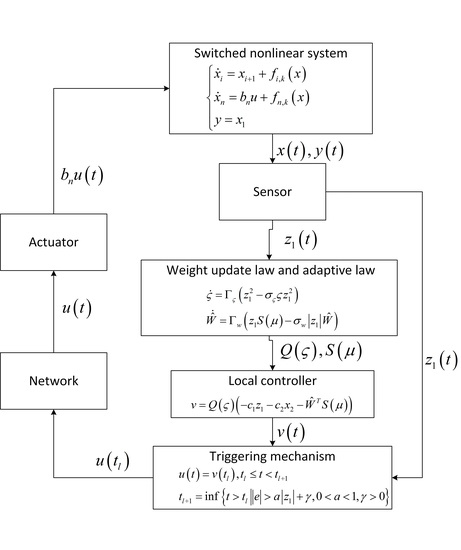Minimal-Approximation-Based Adaptive Event-Triggered Control of Switched Nonlinear Systems with Unknown Control Direction
Abstract
1. Introduction
- When the MFA technology is taken into account, the design methodologies in [22,36] can not be used to address the issue of unknown control direction. To be specific, the un-implementable virtual control laws suffer from a difficulty on exploiting the traditional Nussbaum function methods [22,36] which are considered as a celebrated remedy for dealing subjected to unknown control gains;
- Considering that filtering errors are commonly presented in the backstepping designs including the explosion of complexity [20,21], the MFA technique is thus introduced to the proposed scheme, where the explosion of complexity is solved by designing a group of un-implementable virtual control laws, rather than using the filtering technique. In addition, the scheme no longer needs to employ multiple function approximators in the recursive process, which improves the computational efficiency for the actual control inputs effectively;
- Since the relative threshold strategy [36,37] can not be extended to the MFA framework, an adaptive threshold strategy is considered for the designed ETC problem. The designed ETM not only enhances the communication efficiency in the controller-sensor channel, but also eliminates the parameter limitation problem existing in the relative threshold strategy;
- Different from the Nussbaum function methods using global coordinate transformation information [22,36], a tracking-error-based Nussbaum function is designed to handle the unknown control direction. Then, a boundedness lemma on the Nussbaum function is given to show the boundedness of the Nussbaum function.
2. Preliminaries
3. Main Results
3.1. Controller Design
- Step : According to the recursive manner, is given as:where .
- Step: Following the previous steps, is given as follows:where .
3.2. Stability Analysis
4. Simulation
Discussion
5. Conclusions
- The virtual controllers are designed as intermediate signals that do not need to be implemented, which effectively simplifies the complexity of the conventional backstepping design framework.
- The issue of explosion of complexity existed in the conventional backstepping methods does not need to be considered.
- There no longer needs to employ multiple function approximators in the recursive process, which actually cuts down the computational costs.
Author Contributions
Funding
Data Availability Statement
Acknowledgments
Conflicts of Interest
References
- Yan, Z.; Yang, Z.; Yue, L.; Wang, L.; Jia, H.; Zhou, J. Discrete-time coordinated control of leader-following multiple auvs under switching topologies and communication delays. Ocean Eng. 2019, 172, 361–372. [Google Scholar] [CrossRef]
- Hu, Z.; Ma, C.; Zhang, L.; Halme, A.; Hayat, T.; Ahmad, B. Formation control of impulsive networked autonomous underwater vehicles under fixed and switching topologies. Neurocomputing 2015, 147, 291–298. [Google Scholar] [CrossRef]
- Sugiyama, H. Packet switched power network with decentralized control based on synchronized qos routing. In Proceedings of the ICT & Applications and Collocated Events, Kampala, Uganda, 21–24 March 2012; pp. 147–152. [Google Scholar]
- Gao, H.; Li, Z.; Yu, X.; Qiu, J. Hierarchical multiobjective heuristic for pcb assembly optimization in a beam-head surface mounter. IEEE Trans. Cybern. 2022, 52, 6911–6924. [Google Scholar] [CrossRef]
- Shi, P.; Sun, W.; Yang, X.; Rudas, I.J.; Gao, H. Master-slave synchronous control of dual-drive gantry stage with cogging force compensation. IEEE Trans. Syst. Man Cybern. Syst. 2022, 1–10. [Google Scholar] [CrossRef]
- Liu, Z.; Lin, W.; Yu, X.; Rodríguez-Andina, J.J.; Gao, H. Approximation-free robust synchronization control for dual-linear-motors-driven systems with uncertainties and disturbances. IEEE Trans. Ind. Electron. 2021, 69, 10500–10509. [Google Scholar] [CrossRef]
- Liu, S.; Niu, B.; Zong, G.; Zhao, X.; Xu, N. Data-driven-based event-triggered optimal control of unknown nonlinear systems with input constraints. Nonlinear Dyn. 2022, 1–19. [Google Scholar] [CrossRef]
- Zhang, L.; Zhao, X.; Zhao, N. Real-time reachable set control for neutral singular Markov jump systems with mixed delays. IEEE Trans. Circuits Syst. II Express Briefs 2022, 69, 1367–1371. [Google Scholar] [CrossRef]
- Yuan, S.; Schutter, B.D.; Baldi, S. Adaptive asymptotic tracking control of uncertain time-driven switched linear systems. IEEE Trans. Autom. Control 2016, 62, 5802–5807. [Google Scholar] [CrossRef]
- Zhang, L.; Gao, H. Asynchronously switched control of switched linear systems with average dwell time. Automatica 2010, 46, 953–958. [Google Scholar] [CrossRef]
- Donkers, M.; Heemels, W.; de Wouw, N.V.; Hetel, L. Stability analysis of networked control systems using a switched linear systems approach. IEEE Trans. Autom. Control 2011, 56, 2101–2115. [Google Scholar] [CrossRef]
- Zou, W.; Shi, P.; Xiang, Z.; Shi, Y. Finite-time consensus of second-order switched nonlinear multi-agent systems. IEEE Trans. Neural Networks Learn. Syst. 2019, 31, 1757–1762. [Google Scholar] [CrossRef] [PubMed]
- Zhao, Y.; Zhang, H.; Chen, Z.; Wang, H.; Zhao, X. Adaptive neural decentralised control for switched interconnected nonlinear systems with backlash-like hysteresis and output constraints. Int. Syst. Sci. 2022, 53, 1545–1561. [Google Scholar] [CrossRef]
- Han, T.-T.; Ge, S.S.; Lee, T.H. Adaptive neural control for a class of switched nonlinear systems. Syst. Control Lett. 2009, 58, 109–118. [Google Scholar] [CrossRef]
- Yin, Q.; Wang, M.; Li, X.; Sun, G. Neural network adaptive tracking control for a class of uncertain switched nonlinear systems. Neurocomputing 2018, 301, 1–10. [Google Scholar] [CrossRef]
- Tang, F.; Niu, B.; Wang, H.; Zhang, L.; Zhao, X. Adaptive fuzzy tracking control of switched mimo nonlinear systems with full state constraints and unknown control directions. IEEE Trans. Circuits Syst. II Express Briefs 2022, 69, 2912–2916. [Google Scholar] [CrossRef]
- Hao, S.; Xue, H.; Pan, Y. Adaptive fuzzy dual-performance fault-tolerant control for interconnected nonlinear systems. Int. J. Adapt. Control. Signal Process. 2021, 35, 1685–1711. [Google Scholar] [CrossRef]
- Cheng, F.; Wang, H.; Zhang, L.; Ahmad, A.M.; Xu, N. Decentralized adaptive neural two-bit-triggered control for nonstrict-feedback nonlinear systems with actuator failures. Neurocomputing 2022, 500, 856–867. [Google Scholar] [CrossRef]
- Sui, S.; Chen, C.P.; Tong, S. Neural-network-based adaptive dsc design for switched fractional-order nonlinear systems. IEEE Trans. Neural Netw. Learn. Syst. 2020, 32, 4703–4712. [Google Scholar] [CrossRef]
- Chen, M.; Tao, G.; Jiang, B. Dynamic surface control using neural networks for a class of uncertain nonlinear systems with input saturation. IEEE Trans. Neural Netw. Learn. Syst. 2014, 26, 2086–2097. [Google Scholar] [CrossRef]
- Chen, Z.; Niu, B.; Zhang, L.; Zhao, J.; Ahmad, A.M.; Alassafi, M.O. Command filtering-based adaptive neural network control for uncertain switched nonlinear systems using event-triggered communication. Int. Robust Nonlinear Control 2022, 32, 6507–6522. [Google Scholar] [CrossRef]
- Chen, Z.; Niu, B.; Zhao, X.; Zhang, L.; Xu, N. Model-based adaptive event-triggered control of nonlinear continuous-time systems. Appl. Math. Comput. 2021, 408, 126330. [Google Scholar] [CrossRef]
- Sun, G.; Wang, D.; Li, T.; Peng, Z.; Wang, H. Single neural network approximation based adaptive control for a class of uncertain strict-feedback nonlinear systems. Nonlinear Dyn. 2013, 72, 175–184. [Google Scholar] [CrossRef]
- Choi, Y.H.; Yoo, S.J. Single-approximation-based adaptive control of a class of nonlinear time-delay systems. Neural Comput. Appl. 2016, 27, 1041–1052. [Google Scholar] [CrossRef]
- Choi, Y.H.; Yoo, S.J. Decentralized adaptive output-feedback control of interconnected nonlinear time-delay systems using minimal neural networks. J. Frankl. Inst. 2018, 355, 81–105. [Google Scholar] [CrossRef]
- Choi, Y.H.; Yoo, S.J. Minimal-approximation-based decentralized backstepping control of interconnected time-delay systems. IEEE Trans. Cybern. 2016, 46, 3401–3413. [Google Scholar] [CrossRef] [PubMed]
- Choi, Y.H.; Yoo, S.J. Minimal-approximation-based distributed consensus tracking of a class of uncertain nonlinear multiagent systems with unknown control directions. IEEE Trans. Cybern. 2017, 47, 1994–2007. [Google Scholar] [CrossRef]
- Ma, L.; Xu, N.; Zhao, X.; Zong, G.; Huo, X. Small-gain technique-based adaptive neural output-feedback fault-tolerant control of switched nonlinear systems with unmodeled dynamics. IEEE Trans. Syst. Man Cybern. Syst. 2020, 51, 7051–7062. [Google Scholar] [CrossRef]
- Zhang, L.; Zong, G.; Zhao, X.; Zhao, N. Output reachable set synthesis of event-triggered control for singular markov jump systems under multiple cyber-attacks. IEEE/ACM Trans. Netw. 2022, 1–9. [Google Scholar] [CrossRef]
- Peng, Z.; Jiang, Y.; Wang, J. Event-triggered dynamic surface control of an underactuated autonomous surface vehicle for target enclosing. IEEE Trans. Ind. Electron. 2020, 68, 3402–3412. [Google Scholar] [CrossRef]
- Zhang, Z.; Hao, F.; Zhang, L.; Wang, L. Consensus of linear multi-agent systems via event-triggered control. Int. J. Control 2014, 87, 1243–1251. [Google Scholar] [CrossRef]
- Hu, W.; Liu, L.; Feng, G. Consensus of linear multi-agent systems by distributed event-triggered strategy. IEEE Trans. Cybern. 2015, 46, 148–157. [Google Scholar] [CrossRef] [PubMed]
- Vamvoudakis, K.G. Event-triggered optimal adaptive control algorithm for continuous-time nonlinear systems. IEEE/CAA J. Autom. Sin. 2014, 1, 282–293. [Google Scholar]
- Wang, H.; Xu, K.; Qiu, J. Event-triggered adaptive fuzzy fixed-time tracking control for a class of nonstrict-feedback nonlinear systems. IEEE Trans. Circuits Syst. I Regul. Pap. 2021, 68, 3058–3068. [Google Scholar] [CrossRef]
- Lian, J.; Li, C. Event-triggered control for a class of switched uncertain nonlinear systems. Syst. Control Lett. 2020, 135, 104592. [Google Scholar] [CrossRef]
- Zhang, J.; Xiang, Z. Event-triggered adaptive neural network sensor failure compensation for switched interconnected nonlinear systems with unknown control coefficients. IEEE Trans. Neural Netw. Learn. Syst. 2021, 33, 5241–5252. [Google Scholar] [CrossRef]
- Xing, L.; Wen, C.; Liu, Z.; Su, H.; Cai, J. Event-triggered adaptive control for a class of uncertain nonlinear systems. IEEE Trans. Autom. Control 2016, 62, 2071–2076. [Google Scholar] [CrossRef]
- Wang, B.; Jahanshahi, H.; Volos, C.; Bekiros, S.; Khan, M.A.; Agarwal, P.; Aly, A.A. A new rbf neural network-based fault-tolerant active control for fractional time-delayed systems. Electronics 2021, 10, 1501. [Google Scholar] [CrossRef]
- Chen, C.; Liu, Z.; Zhang, Y.; Chen, C.P.; Xie, S. Saturated nussbaum function based approach for robotic systems with unknown actuator dynamics. IEEE Trans. Cybern. 2015, 46, 2311–2322. [Google Scholar] [CrossRef]
- Chang, Y.; Zhou, P.; Niu, B.; Wang, H.; Xu, N.; Alassafi, M.O.; Ahmad, A.M. Switched-observer-based adaptive output-feedback control design with unknown gain for pure-feedback switched nonlinear systems via average dwell time. Int. J. Syst. Sci. 2021, 52, 1731–1745. [Google Scholar] [CrossRef]
- Wang, C.; Zhang, M.; Li, H.; Wang, N. Event-based adaptive output feedback prescribed performance control for a class of switched nonlinear systems with unknown control directions. Int. J. Control. Syst. 2020, 18, 2482–2491. [Google Scholar] [CrossRef]
- Xia, J.; Zhang, J.; Feng, J.; Wang, Z.; Zhuang, G. Command filter-based adaptive fuzzy control for nonlinear systems with unknown control directions. IEEE Trans. Syst. Man Cybern. Syst. 2019, 51, 1945–1953. [Google Scholar] [CrossRef]
- Ma, J.; Zheng, Z.; Li, P. Adaptive dynamic surface control of a class of nonlinear systems with unknown direction control gains and input saturation. IEEE Trans. Cybern. 2014, 45, 728–741. [Google Scholar] [CrossRef] [PubMed]
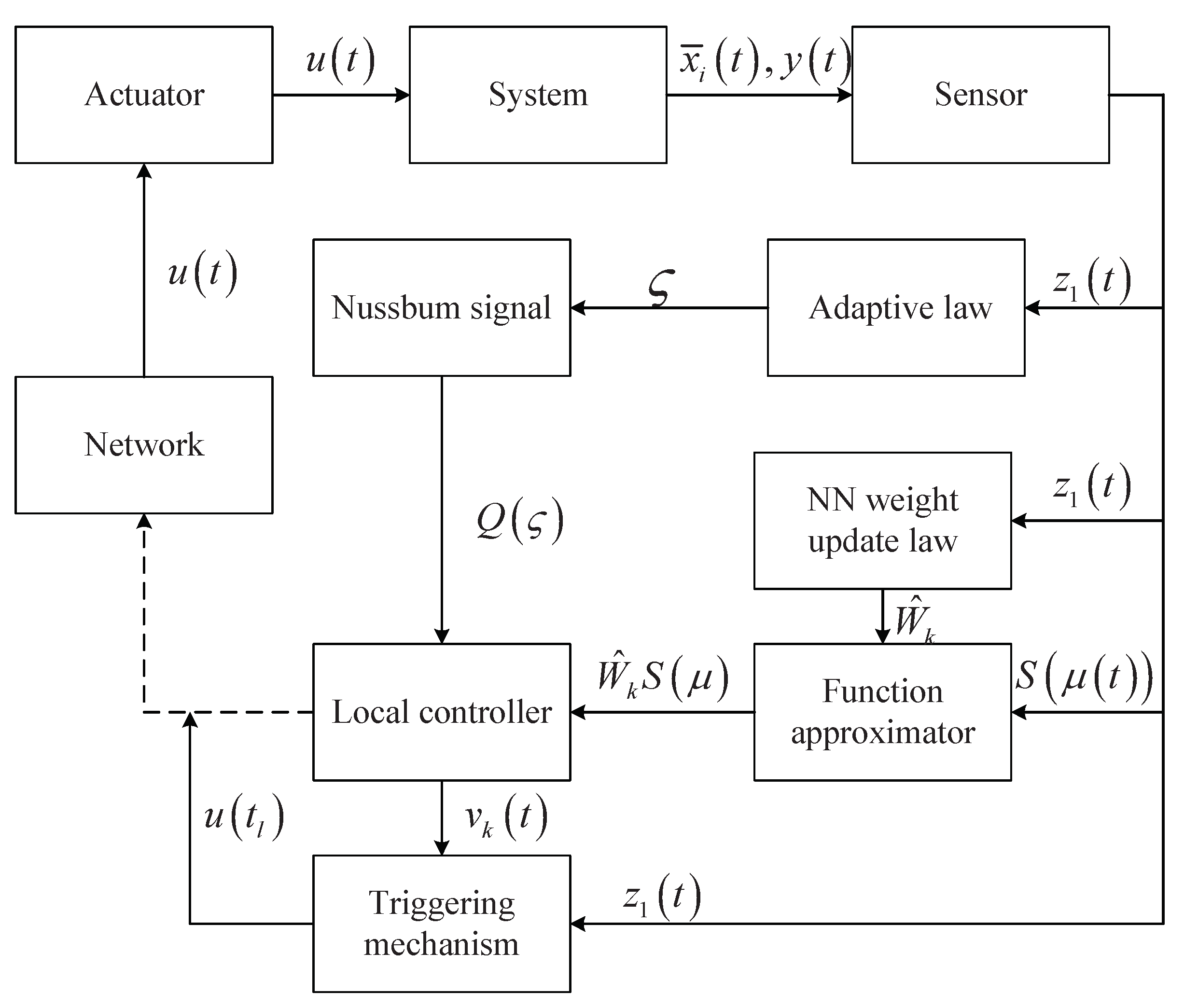
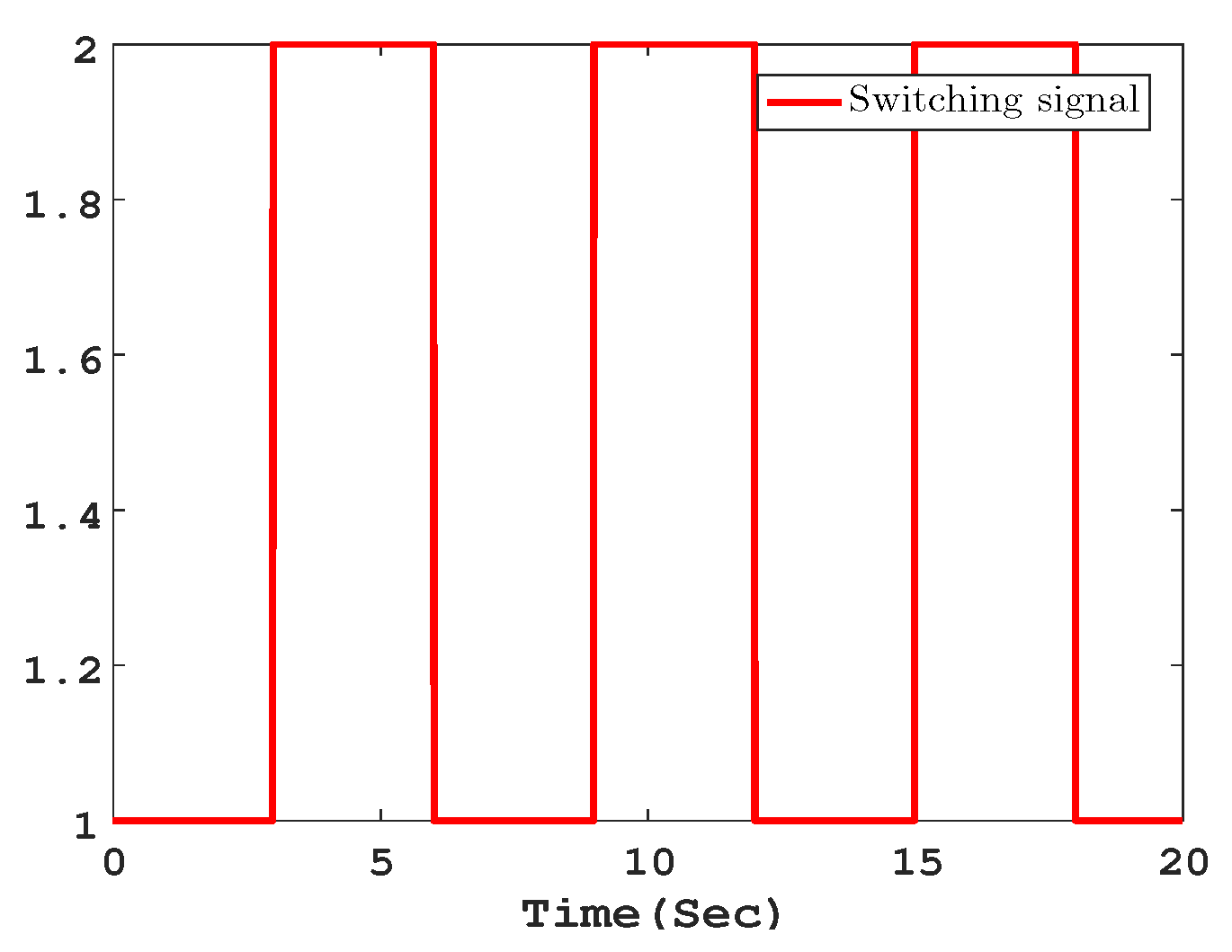
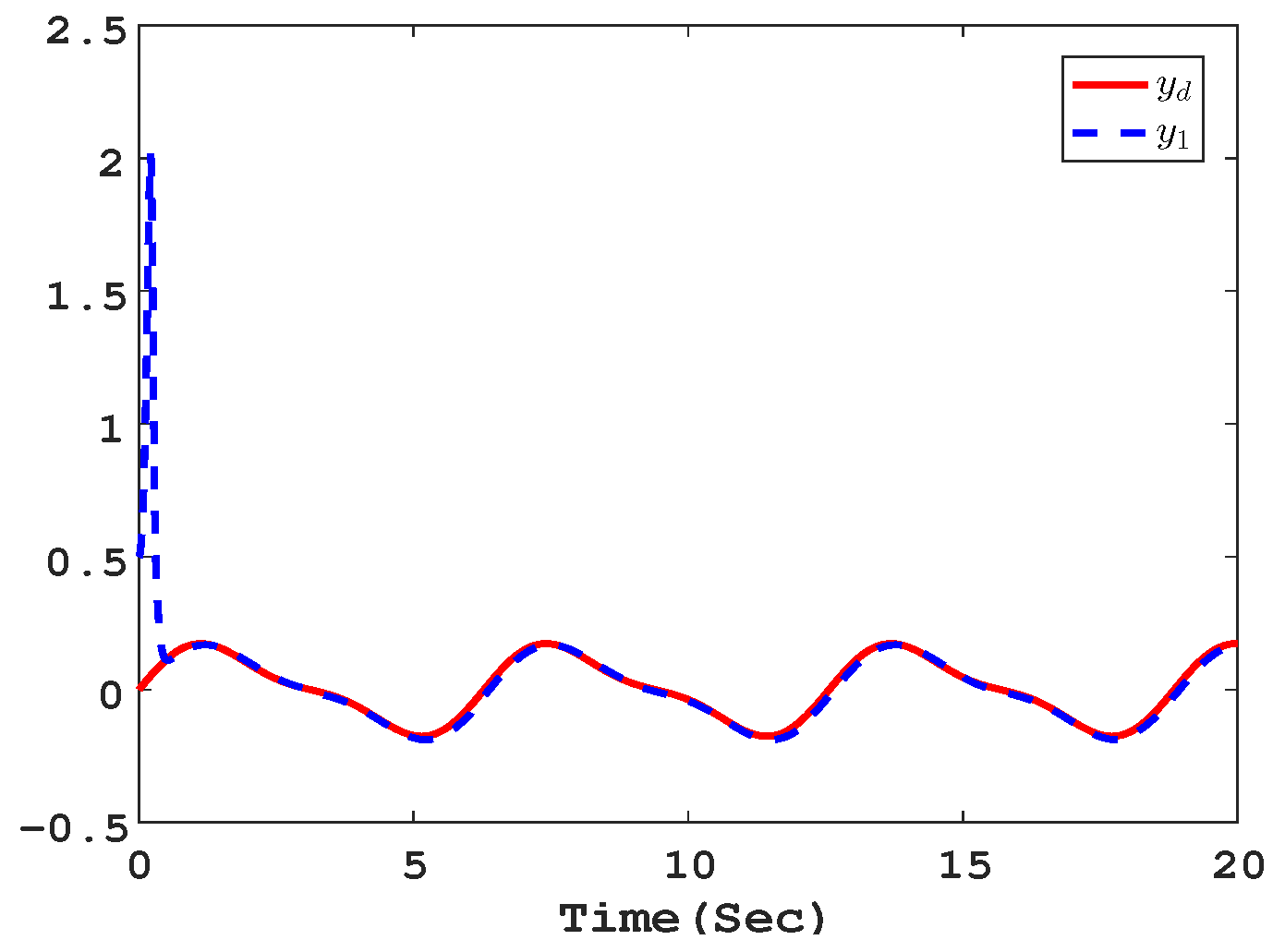
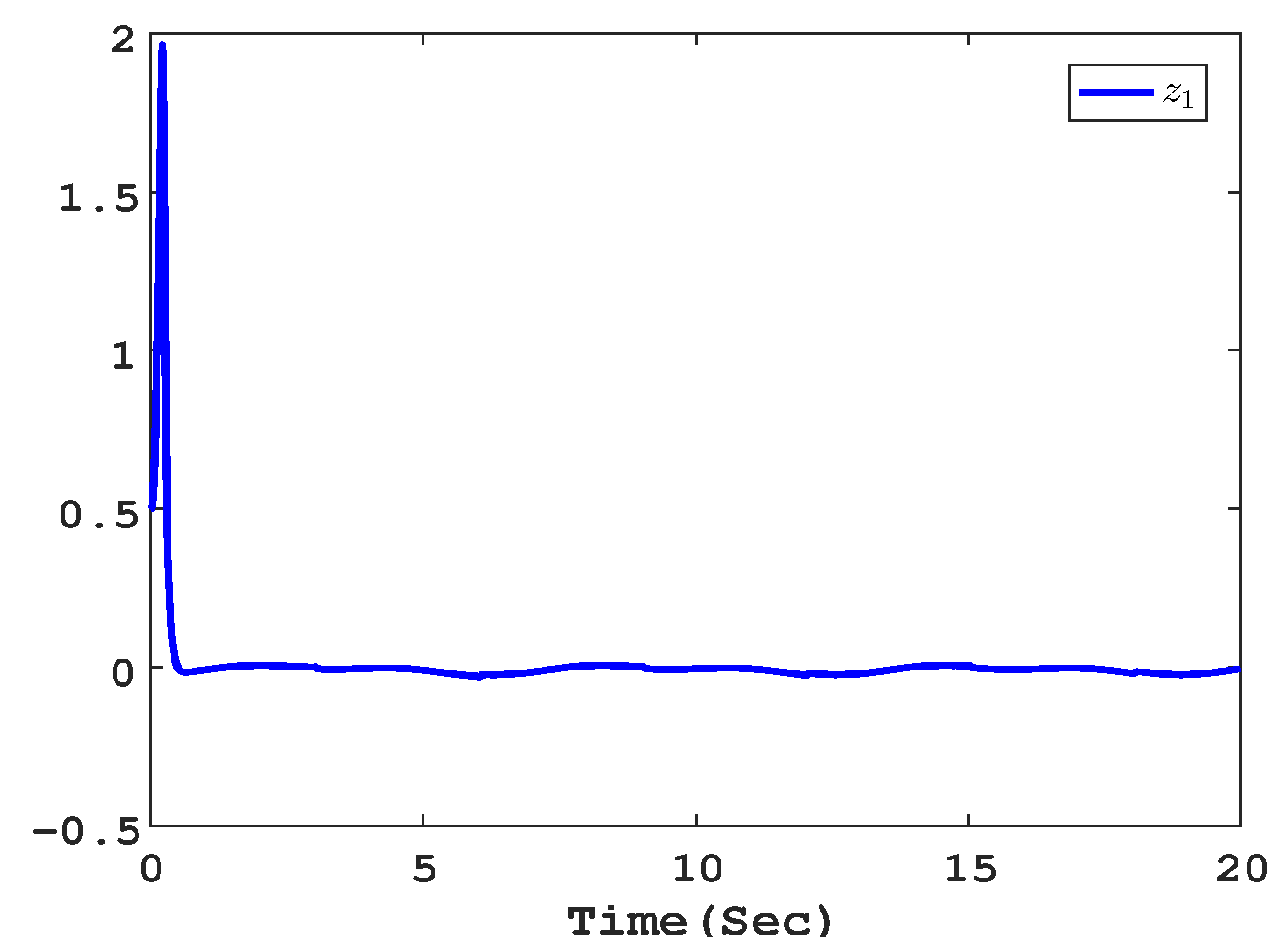
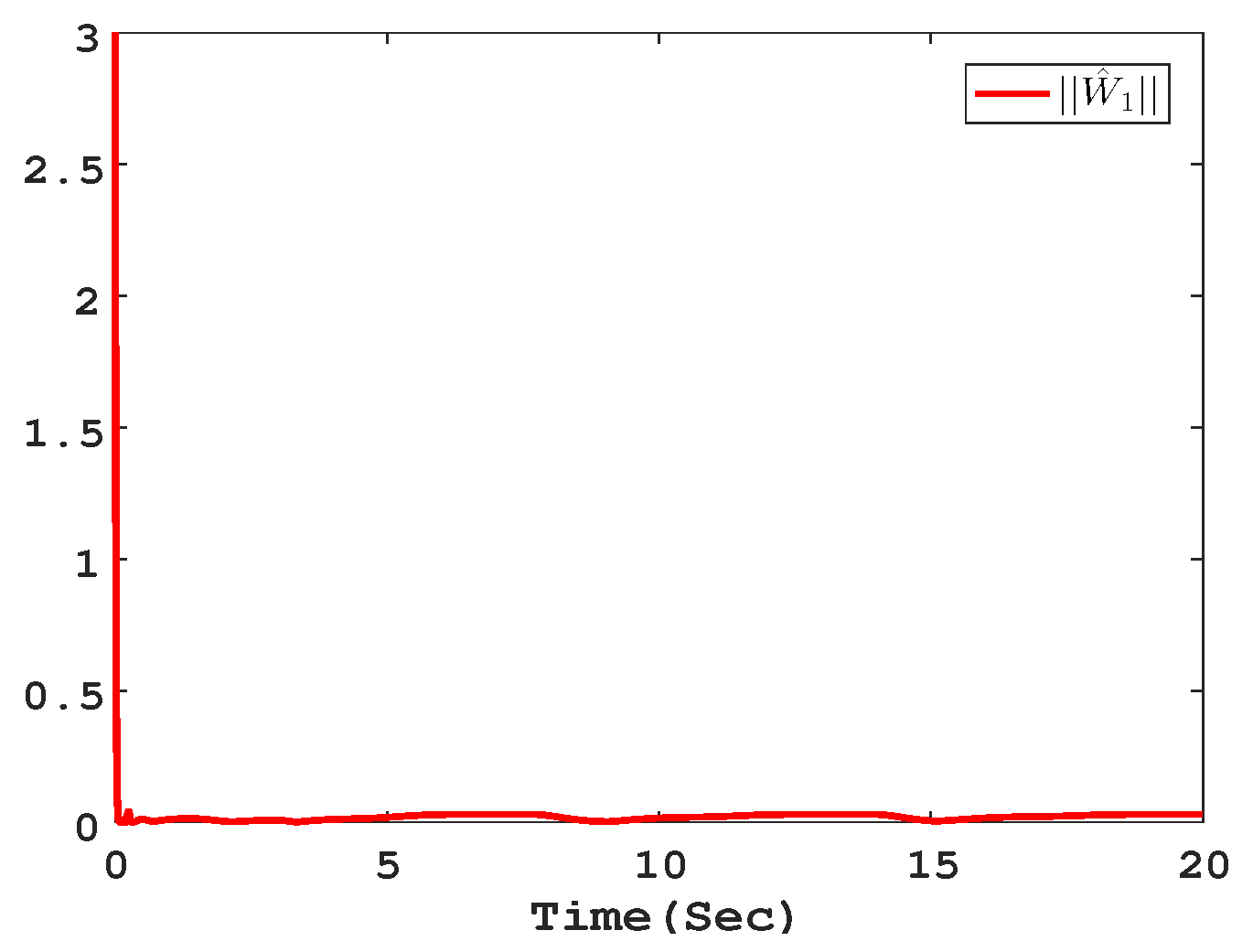
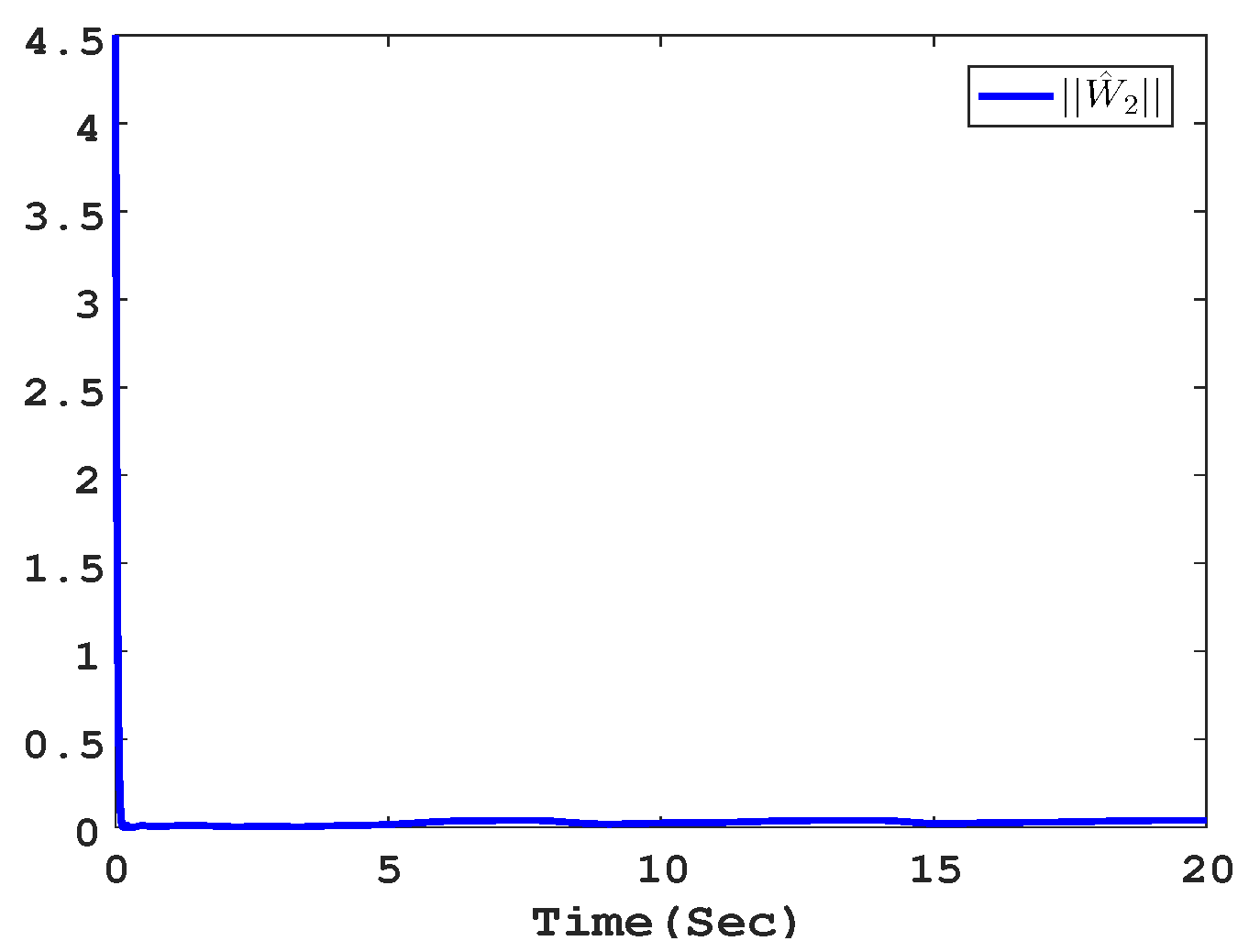
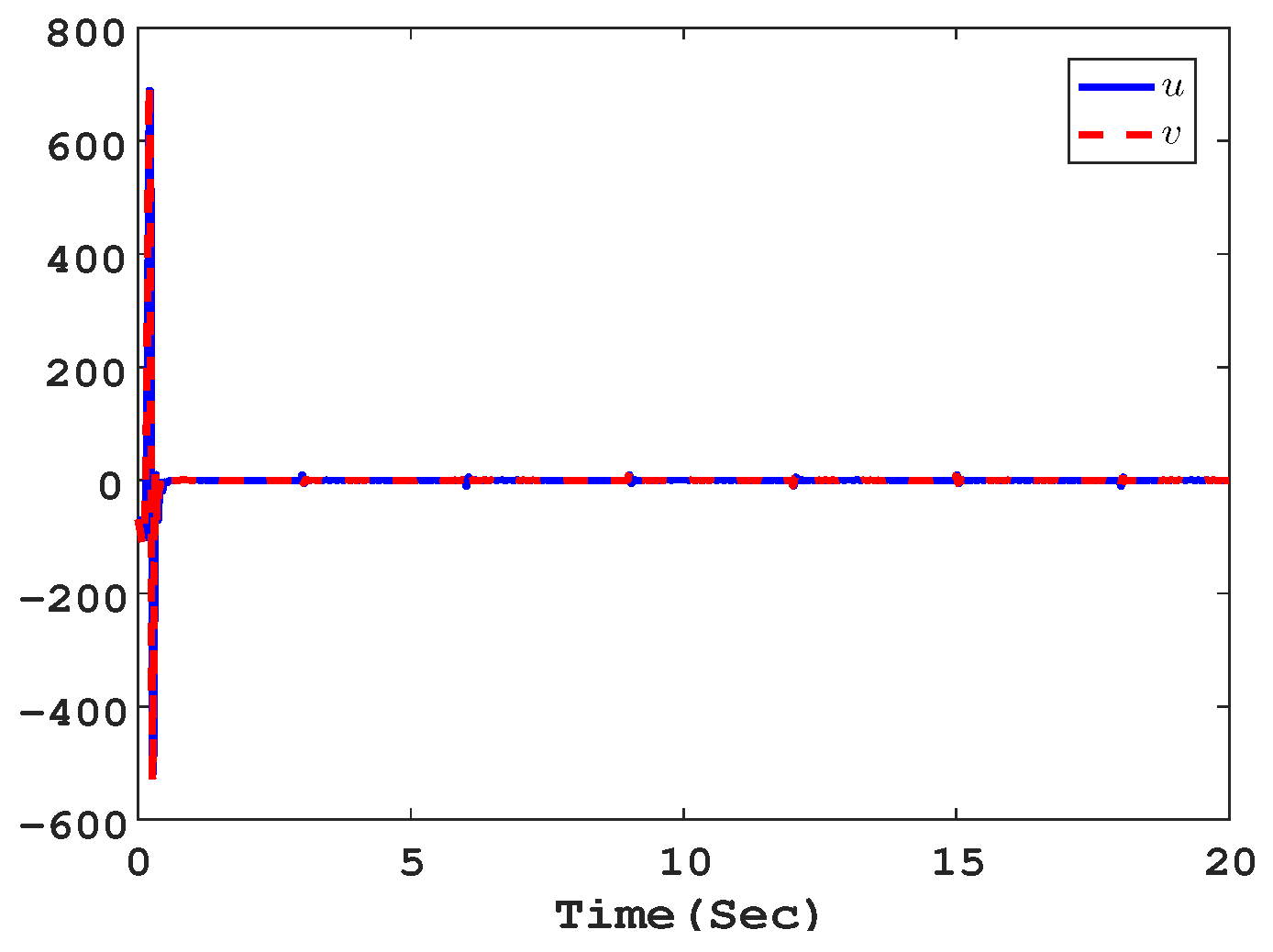
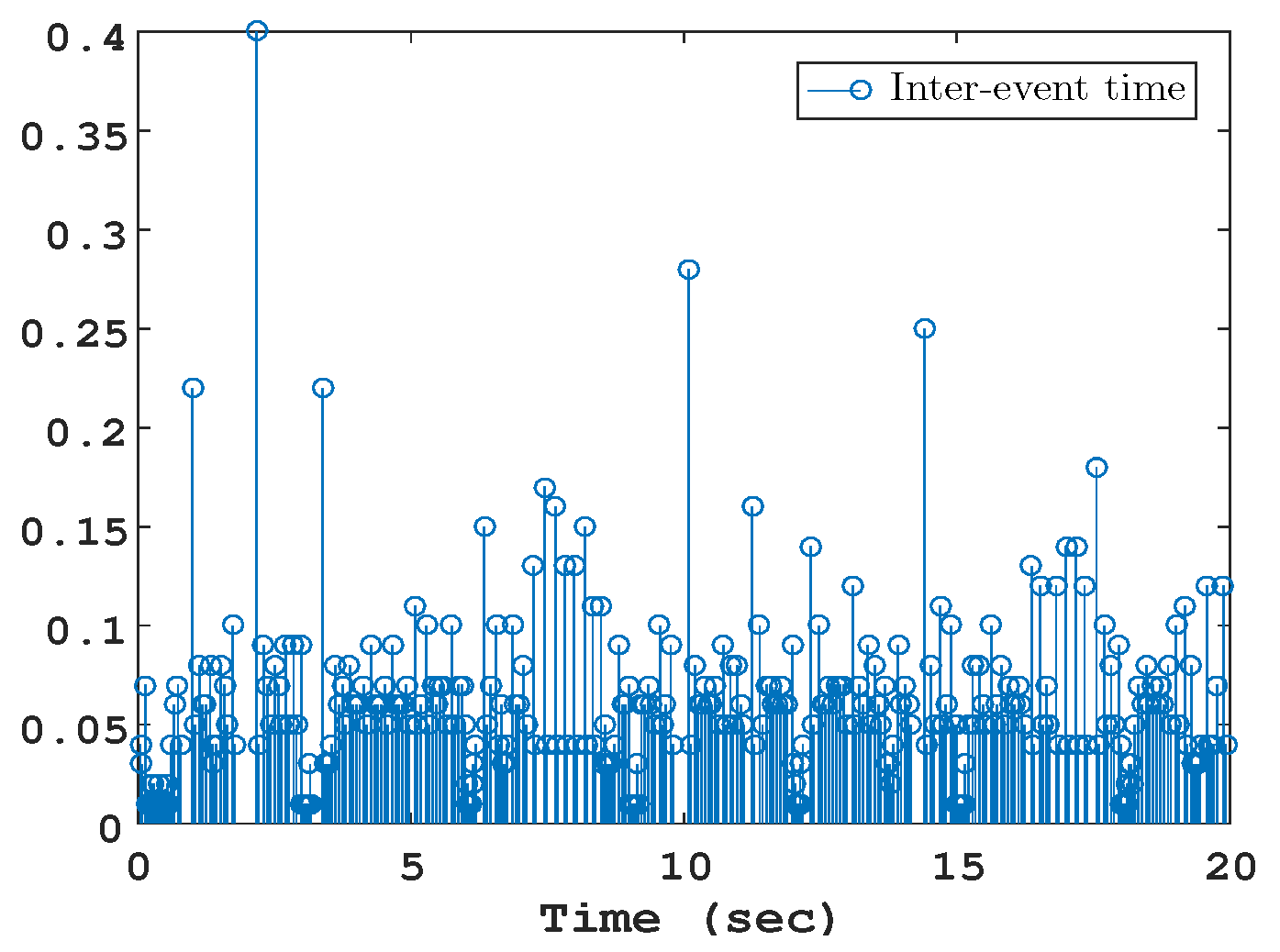
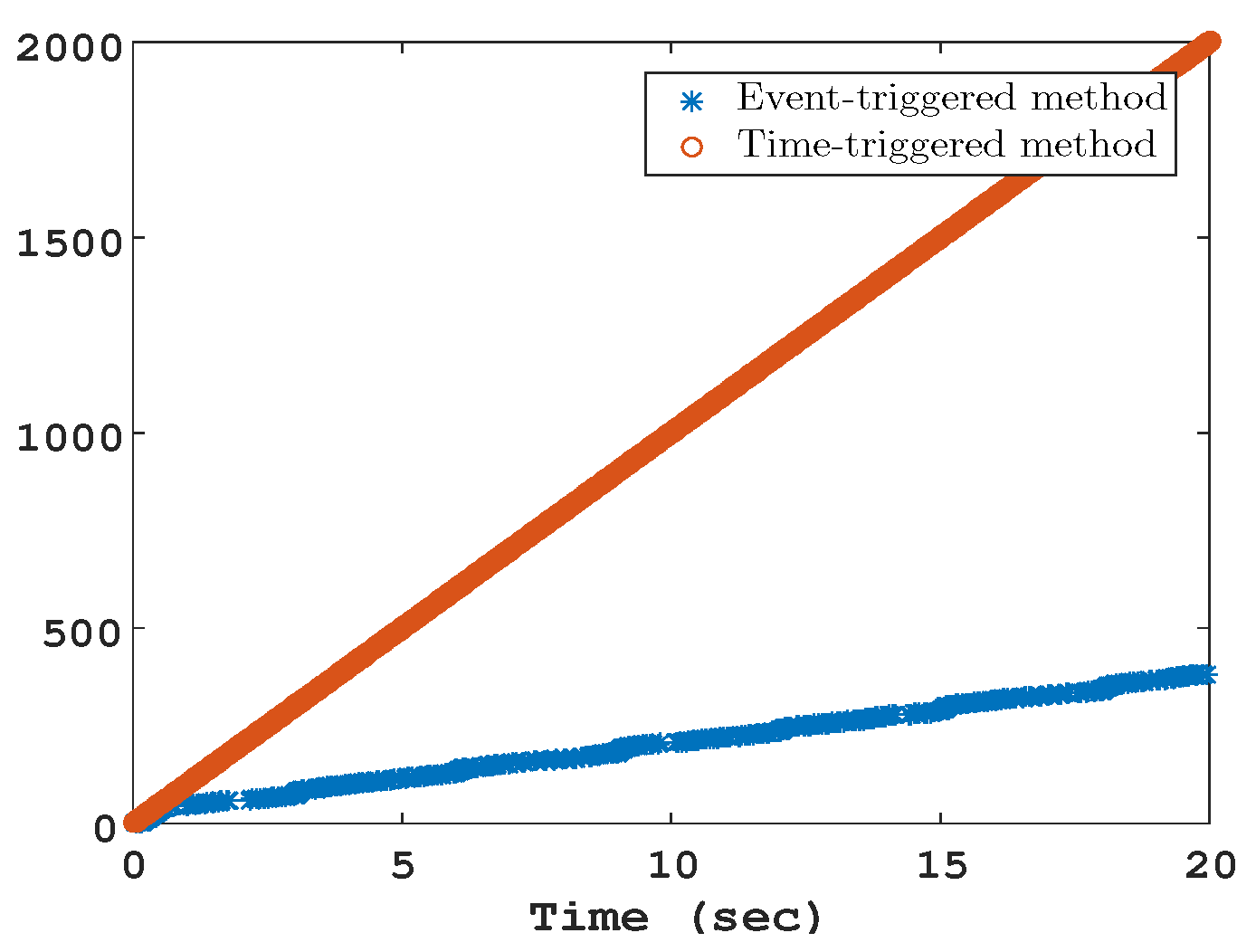
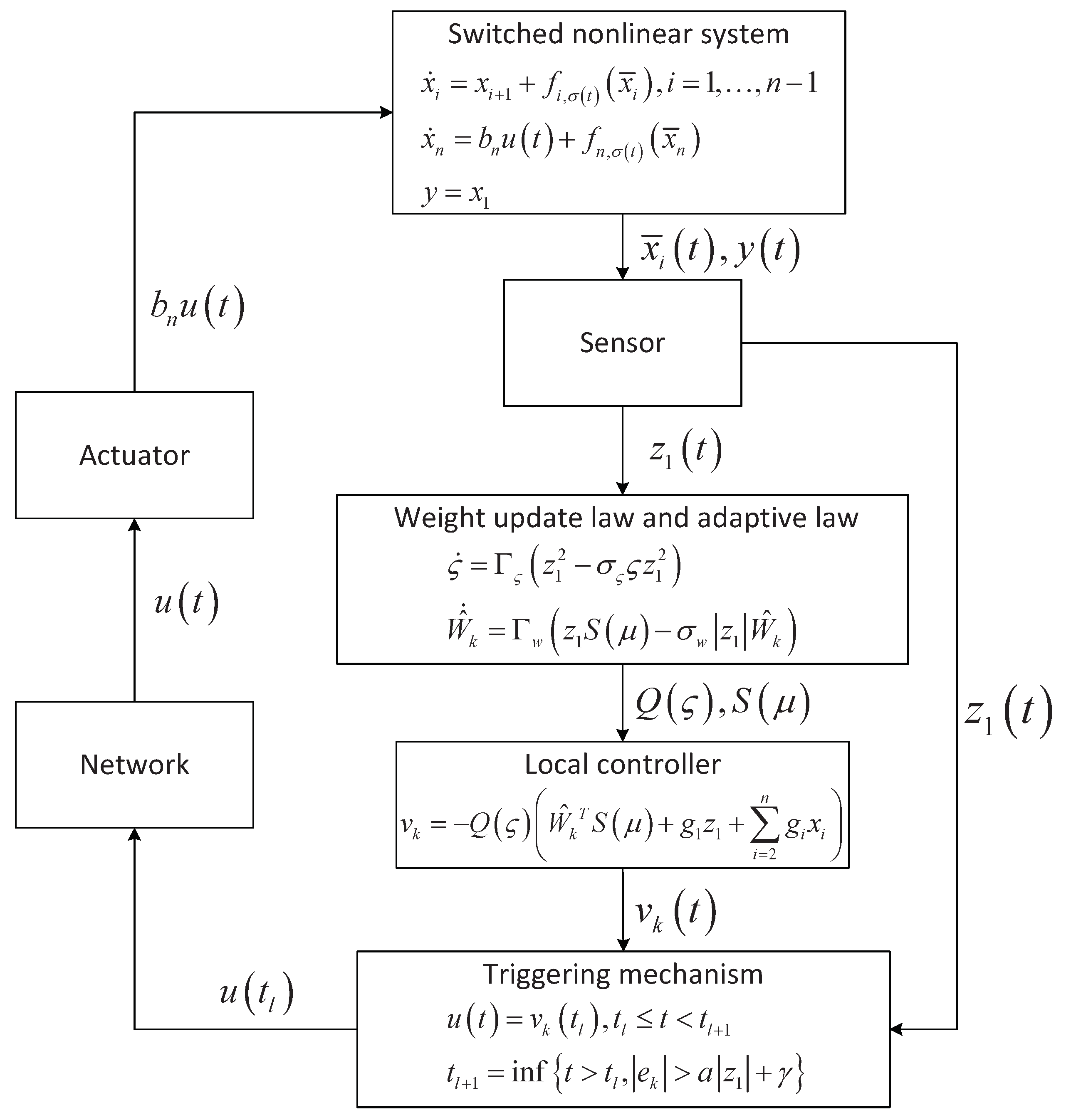
Publisher’s Note: MDPI stays neutral with regard to jurisdictional claims in published maps and institutional affiliations. |
© 2022 by the authors. Licensee MDPI, Basel, Switzerland. This article is an open access article distributed under the terms and conditions of the Creative Commons Attribution (CC BY) license (https://creativecommons.org/licenses/by/4.0/).
Share and Cite
Cao, Y.; Zhao, N.; Xu, N.; Zhao, X.; Alsaadi, F.E. Minimal-Approximation-Based Adaptive Event-Triggered Control of Switched Nonlinear Systems with Unknown Control Direction. Electronics 2022, 11, 3386. https://doi.org/10.3390/electronics11203386
Cao Y, Zhao N, Xu N, Zhao X, Alsaadi FE. Minimal-Approximation-Based Adaptive Event-Triggered Control of Switched Nonlinear Systems with Unknown Control Direction. Electronics. 2022; 11(20):3386. https://doi.org/10.3390/electronics11203386
Chicago/Turabian StyleCao, Yumeng, Ning Zhao, Ning Xu, Xudong Zhao, and Fawaz E. Alsaadi. 2022. "Minimal-Approximation-Based Adaptive Event-Triggered Control of Switched Nonlinear Systems with Unknown Control Direction" Electronics 11, no. 20: 3386. https://doi.org/10.3390/electronics11203386
APA StyleCao, Y., Zhao, N., Xu, N., Zhao, X., & Alsaadi, F. E. (2022). Minimal-Approximation-Based Adaptive Event-Triggered Control of Switched Nonlinear Systems with Unknown Control Direction. Electronics, 11(20), 3386. https://doi.org/10.3390/electronics11203386






